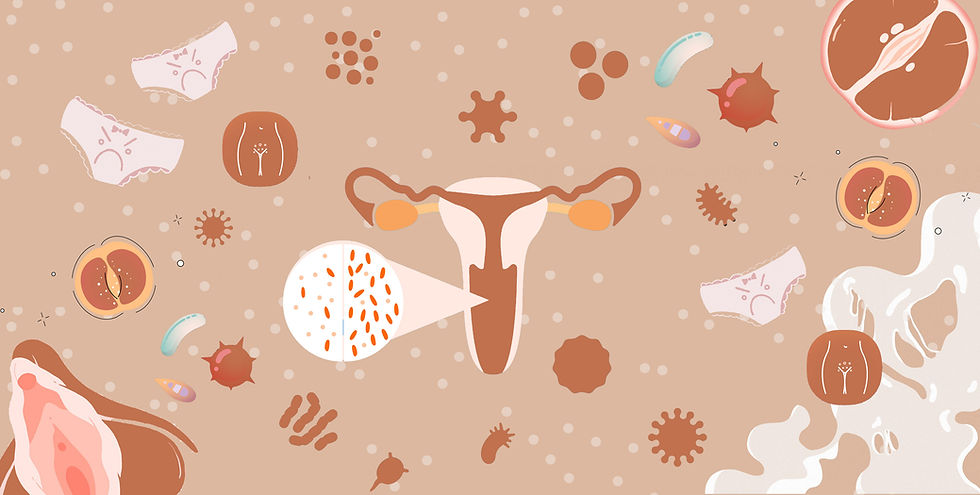Understanding Vaginal Infections: Vulvovaginal Candidiasis
- Taniya Shekhawat
- Oct 23, 2023
- 4 min read
Updated: Oct 25, 2023

Vaginal infection or vaginitis is the infection and inflammation of the vaginal tract and can extend into surrounding areas such as the vulva, cervix, or the reproductive organs.
Vaginal infections are usually caused by 3 microbes: Candida species (a fungus), Gardnerella vaginalis (a bacteria), and Trichomonas vaginalis (a parasite) - which are responsible for causing vulvovaginal candidiasis, bacterial vaginosis (BV), and trichomoniasis, respectively.
In this article we will focus on vulvovaginal candidiasis, which is the second most common vaginal infection after bacterial vaginosis. Around 130 million women are affected globally every year and 75% of all adult women are bound to have it once in their lifetime.
The exact numbers for Singapore are unknown, but it is estimated that around 3800 per 100,000 women are affected, although the actual occurrence might be higher due to the tropical climatic conditions in the country.
What is vulvovaginal candidiasis?
Vulvovaginal candidiasis (also known as candida vulvovaginitis, vaginal thrush, or simply, yeast infection) is an infection of the vulva (the outer area of female genitals) and/or the vagina, and is caused by a class of fungi called Candida.
It’s worthwhile to mention that the fungus Candida and its subspecies like C.albicans are normally present in the human body and seldom cause any harm. This fungus is mostly found on the skin, inside the mouth, throat, gut, and even on the tongue! Rarely, Candida can multiply, grow out of control, and cause an infection, if the environment inside the vagina changes in a way that encourages its growth.
How does vulvovaginal candidiasis or yeast infection occur?
As mentioned before, the presence of Candida in our body is normal, but there are a few predisposing conditions and risk factors that allow it to cause harm. People with underlying health conditions, such as those undergoing treatment for cancer, those with weakened immune systems, or with diabetes, are generally at increased risk of invasive candidiasis.
The risk of getting an infection also increases due to:
Use of antibiotics for another infection
Uncontrolled diabetes mellitus (high blood sugar favors the growth of Candida)
Pregnancy
Immuno-compromised state due to HIV infection (the weak immune system can make one susceptible to opportunistic infections, which are otherwise harmless)
Use of birth control pills (high estrogen favors the growth of Candida)
Use of steroids for other health conditions
Like bacterial vaginosis, vulvovaginal candidiasis or yeast infection is not a sexually transmitted infection (STI) itself, but sexually active individuals are prone to acquiring this infection.

What are the symptoms of a yeast infection?
Some of the most common symptoms of a yeast infection include:
Abnormal vaginal discharge
Redness and/or swelling around the vaginal area
Mild to intense itching in the vaginal area
Vaginal rash
Burning sensation while passing urine
Pain during sexual intercourse
The vaginal discharge can help in identifying the infection. The discharge during a yeast infection is white, thick in consistency, and often resembling yogurt or cottage-cheese in appearance.
If you experience any of the above symptoms, it’s advisable to get tested and consult a doctor.

How to test and diagnose a yeast infection?
A confirmatory diagnosis of a vaginal yeast infection requires a sample collected from the infected area. The sample is placed on a wet mount and observed under the microscope to look for the structures pertinent to Candida.
The final diagnosis is based on both, presence of these microbes as well as symptoms associated with the infection. A positive test in the absence of symptoms usually does not warrant treatment because 10-20% of women harbor Candida or other yeasts in the vagina but do not display any symptoms.
How to treat a yeast infection?
Treatment is usually recommended for those with symptoms. For most mild to moderate infections, anti-fungal drugs are prescribed. Depending upon the severity of the infection, the doctor may choose to provide a longer treatment with a combination of antifungals or other medicines. Some of the commonly prescribed anti-fungal include:
Clotrimazole (as a single dose tablet, cream, or suppository)
Econazole/ miconazole/ nystatin in the form of a suppository
Fluconazole in the form of a tablet
Typically, the duration of treatment ranges from 3 to 7 days. Although longer treatment may be required in high-risk cases such as pregnancy, HIV, and recurrent yeast infections (>4 times in 1 year).
It is advisable to refrain from sex until the treatment is complete.
Treatment of any underlying health conditions such as diabetes may also help in reducing chances of future infections and the doctor might tailor the treatment accordingly.

How to prevent the recurrence of yeast infection?
There are a few things one can do to reduce chances of future recurrence of the infection:
Avoid vaginal douching or using scented soaps and cleansers. Regular bathing is enough.
Avoid tight-fitted clothing as it can trap heat and moisture and favor the growth of fungus. Wear loose-fitted and comfortable clothing.
Use a lubricant and condom during sex. Excess friction might damage the vagina leading to conditions favoring the growth of Candida.
There is no evidence to suggest that treating sexual partners who do not have any symptoms, helps in prevention or recurrence of a vaginal yeast infection.
We hope that this article was helpful. If you suspect a vaginal infection, we encourage you to get tested and consult a doctor. Feel free to reach out to us if you have any questions or concerns, or would like to consult a doctor to discuss the symptoms.

___________
References
Kasper, D. L., et al. Harrison's principles of internal medicine (20th edition.). New York: McGraw Hill Education., 2018. (pg. 981-983)
Ralston, Stuart H. Davidson’s Principles and Practice of Medicine. 23rd ed. Elsevier Health Sciences, 2018. (pg. 335-336)




Comments